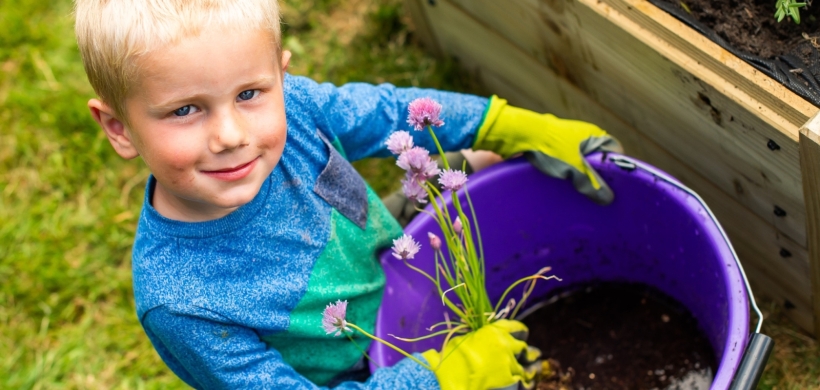At LiveWest, we are Creating Greener Futures Together. Every month, we share some of our favourite Green advice, to help our customers and colleagues live more sustainably.
This month, we are sharing advice on how to grow wildflowers. Read on to find out more. Or, for more eco-friendly advice, visit our Green advice page.
Why grow wildflowers?
Planting wildflowers is a great way to help the environment.
As well as being beautiful to look at, wildflowers provide food for insects, like bees and butterflies, which support other wildlife, like bats and birds.
You can help wildlife in your community by planting wildflowers in your garden or greenspace – even a small space can make a difference.
Visit our Gardening Green Advice page for more advice on helping wildlife in your garden.
What wildflowers should I plant?
To help UK wildlife, it is best to plant native UK wildflowers, with seeds from plants grown in the UK. You can buy a seed mix or choose individual wildflower species based on colour and height, so they will look good in your garden.
Wildflowers need plenty of sunlight to grow. If your garden or green space is shaded, you could look at planting woodland wildflowers, like bluebells, which can grow in shade.
The Wildlife Trusts and Gardeners World websites have some helpful information on choosing which wildflowers to plant.
When to plant wildflowers
The best time to plant wildflowers is in Spring, usually between March and April; or in September.
How to plant wildflowers
There are plenty of ways to grow wildflowers, with options to suit different garden sizes and layouts.
Please check your tenancy agreement or speak to your Housing Officer before making any changes to your garden or green space. Contact us if you are unsure about your agreement, or what your garden responsibilities are.
You should plant your wildflowers in an open and sunny area.
Wildflowers grow best in low quality soil, so you should avoid adding fertilisers or compost. If your soil is very fertile, you may find that grasses overgrow your wildflowers.
If you find that grasses are overgrowing in your garden, you can sow yellow rattle the year before sowing your wildflower seeds. Yellow rattle prevents grasses from growing, helping your wildflowers get enough sunlight and space when you sow them the following year.
How to grow wildflowers in a pot
For smaller spaces, you can sow wildflowers in gaps in your borders or even grow wildflowers in a raised bed or plant pot. Follow the steps below to get started:
- Choose a plant pot with good drainage, and place some rocks in the bottom of it.
- Fill the pot with peat-free compost and soil, up to about 2.5cm from the top of the pot.
- Scatter your wildflower seeds on top of the soil/compost mix.
- Scatter 1cm of your soil/compost mix on top of the seeds, then water.
- Place your pot in an open and sunny spot.
- Water weekly and wait for your wildflowers to bloom, then enjoy all the wildlife!
Once your wildflowers have bloomed, leave them to go to seed. You can collect the seeds and sow them again next year. Then, once everything has flowered, you can cut the wildflowers back to around 2.5cm high.
How to grow a wildflower patch
If you are able to, you could grow your own mini wildflower meadow or wildflower patch, by laying wildflower turf, planting wildflower plugs or sowing wildflower seed. Follow the steps below to get started:
- Choose an open and sunny area of your garden.
- Rake the ground to create a seedbed.
- Avoid adding fertiliser.
- Sow your seeds in Spring or Autumn.
- Scatter half of the seed lengthways and the rest widthways, to make sure you have an even cover. You can mix the seed with silver sand to see more easily where you have sown. You will need between 3g and 5g of seed per square metre, depending on the type of seed mix you use.
- Lightly rake the seed you have sown, then water.
- Water weekly and wait for your wildflowers to bloom, then enjoy all the wildlife!
The RSPB and Wildlife Trusts share some helpful guides to growing a wildflower patch in your garden, which you can read for more information.
Once your wildflowers have bloomed, leave them to go to seed. Read on to find out more about how to care for your wildflower patch.
When will I see the flowers?
If you plant your seeds in the Spring, you will get your first blooms in the Summer, but the main bloom will happen the following Spring.
If you plant in Autumn, your wildflowers will bloom the following Spring.
How to care for your wildflowers
If you have created a wildflower patch or mini meadow, in the first year you will need to cut it back to about 2.5cm of plant growth, in midsummer. Leave the cuttings on the ground for a few days after cutting, to let the seeds drop back onto the soil. After the first year, it is important not to cut your meadow area between April and September – this allows as many wildflowers to bloom as possible.
You may want to remove some weeds, such as thistles, nettles and docks, by hand-weeding.
You can control grass in your wildflower patch by sowing yellow rattle, which will stop grass from growing there.
The Royal Horticultural Society share some helpful information on how to care for your wildflowers.
How to grow wildflowers when you don’t have a garden
You can still grow wildflowers if you don’t have a garden.
You can grow wildflowers in a window box or a plant pot. You may also be able to grow wildflowers in a community garden or allotment, if you have one.
Where can I find out more about wildlife friendly gardening?
You can visit our Gardening Green Advice page for more tips on eco-friendly gardening.
Our Gardening page is also full of useful resources, plus information on your responsibilities in looking after your garden.
Please check your tenancy agreement or speak to your Housing Officer before making any changes to your garden or green space. Contact us if you are unsure about your agreement, or what your garden responsibilities are.

